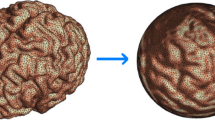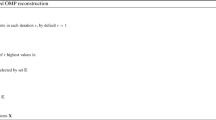Abstract
In this paper, we propose a separation algorithm for weakly correlated source signals. At present, there are many blind source separation algorithms based on independent component analysis, which can only deal with the separation of uncorrelated source signals. However, the assumption that the source signals are independent is too strict in practical application, so the application of the separation algorithm is limited. The proposed weak correlation source signal separation algorithm is divided into two stages. In the first stage, the correlation matrices of mixed signals are first decomposed into two parts, and then their image matrices are introduced. Finally, the objective function is constructed. Using the iterative algorithm to compute this function, we prove that when the function tends to zero, similar matrices of independent parts of the aforementioned correlation matrices are obtained. In the second stage, the joint diagonal matrix model is established by using these similarity matrices, and finally the separable separation matrix is obtained by optimizing the model so as to achieve the purpose of separating the source signals. Simulation experiments also verify the effectiveness of the algorithm.







Similar content being viewed by others
References
Langkam, S., Deb, A. K. (2016). Linear blind source separation: A dual state-parameter estimation approach. In 2015 39th National systems conference (NSC) (pp. 1–5). IEEE
Choi, S., & Cichocki, A. (1997). Adaptive blind separation of speech signals: Cocktail party problem. International conference on speech processing (pp. 617–622)
Dey, B., Hossain, A., Dey, R., et al. (2019). Integrated blind signal separation and neural network based energy detector architecture. Wireless Personal Communications, 106(4), 2315–2333.
Roy, V., & Shukla, S. (2019). Designing efficient blind source separation methods for EEG motion artifact removal based on statistical evaluation. Wireless Personal Communications, 108, 1311.
Yu, C. (2017). Steganography of digital watermark by Arnold scrambling transform with blind source separation morphological component analysis. Multimedia Tools and Applications, 76(5), 6821–6842.
Zhang, Wei Tao, Lou, S. T., & Zhang, Y. L. (2010). Robust nonlinear power iteration algorithm for adaptive blind separation of independent signals. Digital Signal Processing, 20(2), 541–551.
Pendharkar, G., Naik, G. R., & Nguyen, H. T. (2014). Using blind source separation on accelerometry data to analyze and distinguish the toe walking gait from normal gait in ITW children. Biomedical Signal Processing and Control, 13(4), 41–49.
Zeng, T. J., & Feng, Q. Y. (2014). Non-orthogonal joint diagonalization algorithm based on hybrid trust region method and its application to blind source separation. Neurocomputing, 133, 280–294.
Zeng, T. J., & Feng, Q. Y. (2014). A parallel dual matrix method for blind signal separation. Neural Computation, 26(3), 592–610.
Cheriyan, M. M., Michael, P. A., & Kumar, A. (2018). Blind source separation with mixture models—A hybrid approach to MR brain classification. Magnetic Resonance Imaging, 54, 137–147.
Inan, H. A., & Erdogan, A. T. (2014). A convolutive bounded component analysis framework for potentially nonstationary independent and/or dependent sources. IEEE Transactions on Signal Processing, 63(1), 18–30.
Su, Q., Shen, Y., Deng, C., et al. (2016). A fast algorithm for the separation of dependent sources based on bounded component analysis. Communications in China (ICCC). In 2016 IEEE/CIC International Conference on (pp. 1–6). IEEE
Cruces, S. (2010). Bounded component analysis of linear mixtures: a criterion for minimum convex perimeter. IEEE Transactions on Signal Process, 58, 2141–2154.
Hyvarinen, A. (1999). Fast and robust fixed-point algorithms for independent component analysis. IEEE Transactions on Neural Networks, 10, 626–634.
Li, Z. (2014). A novel solution for the coupled faults isolation in gear pairs using the conception of frequency tracking. Elektronika ir Elektrotechnika, 20, 69–72.
Erdogan, A. T. (2013). A class of bounded component analysis algorithms for the separation of both dependent and independent sources. IEEE Transactions on Signal Process, 61, 5730–5743.
Aguilera, P., Cruces, S., Duran-Diaz, I., Sarmiento, A., & Mandic, P. (2013). Blind separation of dependent sources with a bounded component analysis deflationary algorithm. IEEE Signal Processing Letters, 20, 709–712.
Li, Z., Yan, X., Wang, X., & Peng, Z. (2016). Detection of gear cracks in a complex gearbox of wind turbines using supervised bounded component analysis of vibration signals collected from multi-channel sensors. Journal of Sound and Vibration, 371, 406–433.
Su, Q., Shen, Y., Deng, C., Zhao, W., Zhang, L. (2016). A fast algorithm for the separation of dependent sources based on bounded component analysis. In 2016 IEEE/CIC International conference on communications in China (ICCC) (pp. 1–6). IEEE
Erdogan, A. T. (2013). A class of bounded component analysis algorithms for the separation of both independent and dependent sources. IEEE Transactions on Signal Processing, 61(22), 5730–5743.
Acknowledgements
This work was supported by the National Natural Science Foundation of China (NSFC) under Grant 61561041; The National key research and development plan under Grant 2017YFB0504203; and the Fund Project of XJPCC(2019AB001, 2017CD010 and 2017CA018).
Author information
Authors and Affiliations
Corresponding author
Additional information
Publisher's Note
Springer Nature remains neutral with regard to jurisdictional claims in published maps and institutional affiliations.
Rights and permissions
About this article
Cite this article
Zeng, T., Liu, C. A Two-Stage Separation Algorithm for Weak Correlation Source Signals. Wireless Pers Commun 117, 2441–2452 (2021). https://doi.org/10.1007/s11277-020-07983-y
Accepted:
Published:
Issue Date:
DOI: https://doi.org/10.1007/s11277-020-07983-y




